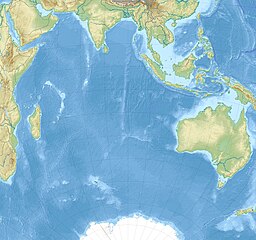| Indian Ocean | |
|---|---|
 Extent of the Indian Ocean according to the International Hydrographic Organization | |
 Topographic/bathymetric map of the Indian Ocean region | |
| Coordinates | 20°S 80°E / 20°S 80°E |
| Type | Ocean |
| Primary inflows | Zambezi, Ganges-Brahmaputra, Indus, Jubba, and Murray (largest 5) |
| Catchment area | 21,100,000 km2 (8,100,000 sq mi) |
| Basin countries | South and Southeast Asia, Western Asia, Northeast, East and Southern Africa and Australia |
| Max. length | 9,600 km (6,000 mi) (Antarctica to Bay of Bengal)[1] |
| Max. width | 7,600 km (4,700 mi) (Africa to Australia)[1] |
| Surface area | 70,560,000 km2 (27,240,000 sq mi) |
| Average depth | 3,741 m (12,274 ft) |
| Max. depth | 7,290 m (23,920 ft) (Sunda Trench) |
| Shore length1 | 66,526 km (41,337 mi)[2] |
| Islands | Madagascar, Sri Lanka, Maldives, Reunion, Seychelles, Mauritius |
| Settlements | Cities, ports and harbours list |
| References | [3] |
| 1 Shore length is not a well-defined measure. | |
The Indian Ocean is the third-largest of the world's five oceanic divisions, covering 70,560,000 km2 (27,240,000 sq mi) or approximately 20% of the water area of Earth's surface.[4] It is bounded by Asia to the north, Africa to the west and Australia to the east. To the south it is bounded by the Southern Ocean, or Antarctica, depending on the definition in use.[5] The Indian Ocean has large marginal, or regional seas, such as the Andaman Sea, the Arabian Sea, the Bay of Bengal, and the Laccadive Sea.
Once called the Eastern Ocean, it is now named after India, which protrudes into it, and has been known by its current name since at least 1515. It is the only ocean named after a country. It has an average depth of 3,741 m. All of the Indian Ocean is in the Eastern Hemisphere. Unlike the Atlantic and Pacific, the Indian Ocean is bordered by landmasses and an archipelago on three sides, making it more like an embayed ocean centered on the Indian Peninsula. Its coasts and shelves differ from other oceans, with distinct features, such as a narrower continental shelf. In terms of geology, the Indian Ocean is the youngest of the major oceans, with active spreading ridges and features like seamounts and ridges formed by hotspots.
The climate of the Indian Ocean is characterized by monsoons. It is the warmest ocean, with a significant impact on global climate due to its interaction with the atmosphere. Its waters are affected by the Indian Ocean Walker circulation, resulting in unique oceanic currents and upwelling patterns. The Indian Ocean is ecologically diverse, with important marine life and ecosystems like coral reefs, mangroves, and sea grass beds. It hosts a significant portion of the world's tuna catch and is home to endangered marine species. It faces challenges like overfishing and pollution, including a significant garbage patch.
Historically, the Indian Ocean has been a hub of cultural and commercial exchange since ancient times. It played a key role in early human migrations and the spread of civilizations. In modern times, it remains crucial for global trade, especially in oil and hydrocarbons. Environmental and geopolitical concerns in the region include the effects of climate change, piracy, and strategic disputes over island territories.
- ^ a b Demopoulos, Smith & Tyler 2003, Introduction, p. 219
- ^ Keesing & Irvine 2005, Introduction, p. 11–12; Table 1, p.12
- ^ CIA World Fact Book 2018
- ^ Eakins & Sharman 2010
- ^ "'Indian Ocean' — Merriam-Webster Dictionary Online". Archived from the original on 16 October 2013. Retrieved 7 July 2012.
ocean E of Africa, S of Asia, W of Australia, & N of Antarctica area ab 73,427,795 square kilometres (28,350,630 sq mi)
